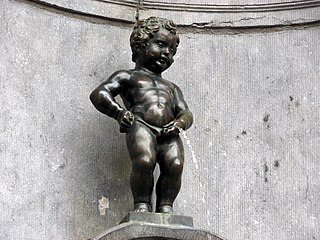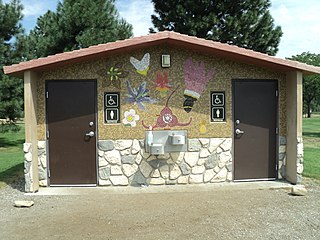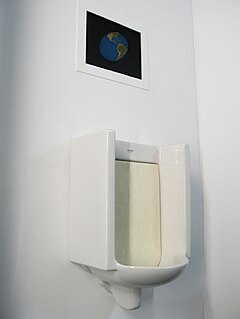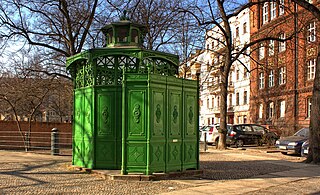
Urolagnia is a paraphilia in which sexual excitement is associated with the sight or thought of urine or urination.

Urination is the release of urine from the urinary bladder through the urethra to the outside of the body. It is the urinary system's form of excretion. It is also known medically as micturition, voiding, uresis, or, rarely, emiction, and known colloquially by various names including peeing, weeing, and pissing.

A urinal is a sanitary plumbing fixture for urination only. Urinals are often provided in public toilets for male users in Western countries. They are usually used in a standing position. Urinals can be with automatic or manual flushing, or without flush water as is the case for waterless urinals. They can be arranged as single sanitary fixtures or in a trough design without privacy walls. Urinals designed for females also exist but are rare. It is possible for females to use male urinals with a female urination device.

Some toilets in Japan are more elaborate than toilets commonly found in other developed nations. The current state of the art for Western-style toilets in Japan is the bidet toilet, which, as of March 2016, is installed in 81% of Japanese households. In Japan, these bidets are commonly called washlets, a brand name of Toto Ltd., and include many advanced features rarely seen outside of Asia. The feature set commonly found on washlets are anal hygiene, bidet washing, seat warming, and deodorization. Japanese toilets are well-known in popular culture and often parodied in comedic works set in Japan.

A public toilet is a room or small building with toilets that does not belong to a particular household. Rather, the toilet is available for use by the general public, customers, travellers, employees of a business, school pupils, prisoners etc. Public toilets are commonly separated into male and female facilities, although some are unisex, especially for small or single-occupancy public toilets. Increasingly, public toilets are accessible to people with disabilities. Public toilets are known by many other names depending on the country. Examples are: restroom, bathroom, men's room, women's room in the US, washroom in Canada, and toilets, lavatories, water closet (W.C.), ladies and gents in Europe.

Fountain is a readymade sculpture produced by Marcel Duchamp in 1917: a porcelain urinal signed "R.Mutt". In April 1917, an ordinary piece of plumbing chosen by Duchamp was submitted for an exhibition of the Society of Independent Artists, the inaugural exhibition by the Society to be staged at The Grand Central Palace in New York. In Duchamp's presentation, the urinal's orientation was altered from its usual positioning. Fountain was not rejected by the committee, since Society rules stated that all works would be accepted from artists who paid the fee, but the work was never placed in the show area. Following that removal, Fountain was photographed at Alfred Stieglitz's studio, and the photo published in The Blind Man. The original has been lost.

Potty parity is equal or equitable provision of public toilet facilities for females and males within a public space.

The term unisex public toilets refers to public toilets that are not separated by gender or sex. Unisex public toilets can benefit a range of people with or without special needs, for example people with disabilities, the elderly, and anyone who needs the help of someone of another gender or sex. They are also valuable for parents wishing to accompany one or more of their young children needing a toilet facility.

A female urination device, female urination aid, or stand-to-pee device (STP) is a device which aids a woman or girl to urinate while standing upright. Variations include basic disposable funnels to more elaborate reusable designs. Female urination devices have increased in popularity since the 1990s. They are used for outdoor pursuits, and for medical reasons.

A female urinal is designed for the anatomy of women, to allow ease of use by women and girls. Different models enable urination in standing, semi-squatting, or squatting postures, always without direct bodily contact with the urinal. Sitting models also exist, but with direct bodily contact with the urinal.
In health care, toileting is the act of assisting a dependent patient with his/her elimination needs.

A urinal is a bottle for urination. It is most frequently used in health care for patients who find it impossible or difficult to get out of bed during sleep. Urinals allow the patient who has cognition and movement of their arms to toilet independently.

Urine diversion, also called urine separation or source separation, refers to the separate collection of human urine and feces at the point of their production, i.e. at the toilet or urinal. Separation of urine from feces allows human waste to be treated separately and used as a potential resource. Applications are typically found where connection to a sewer-based sanitation system is not available or areas where water supplies are limited.

An interactive urinal is a device that allows users to play video games or control interactive displays while urinating. Several designs have been produced to date, usually comprising a urinal fitted with a pressure sensor to measure the strength and position of the urine flow and an LCD screen mounted above the urinal to provide animated graphics.

A pissoir or vespasienne is a structure that provides support and screening of urinals in public space. It is a French invention common in Europe that allows for urination in public without the need for a toilet building. The availability of pissoirs is likely to reduce urination onto buildings, sidewalks, or streets.

Pollee is a mobile female urinal, designed by Nuala Collins, Christian Pagh and Sara Nanna and are produced by the Danish design bureau UIWE. It is specifically designed to be used at public events such as concerts of music festivals.

Anti urination devices were a form of hostile architecture installed in Norwich and the surrounding area in the late 19th century to discourage public urination. The overcrowded and narrow streets of the city centre and a lack of public toilets led to men urinating against the side of buildings, but the installation of new public urinals to address the issue was delayed by disputes over where they were to be sited. Anti urination devices were built in places which suffered particular problems with public urination, and were intended to discourage men from urinating at that spot. Most were built of sloped or curved stone, flint or concrete, and were shaped such that anyone attempting to urinate against the wall would need to stand well away from the wall in public view, hopefully discouraging them from doing so. The slope of the structure meant that should anyone still attempt to urinate against it, the stream of urine would be deflected back onto their feet and legs. A few instead consisted of a spiked metal bar positioned across a corner at the height of a typical man's groin, and were intended to dissuade men from approaching the corner with their genitals exposed.


















